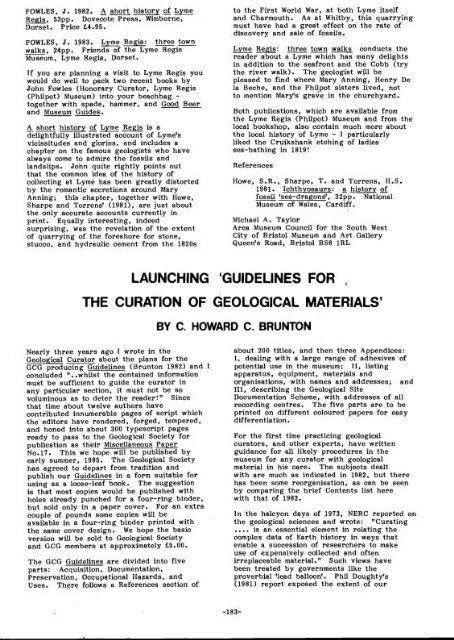Number 3 - Geological Curators Group
Number 3 - Geological Curators Group
Number 3 - Geological Curators Group
Create successful ePaper yourself
Turn your PDF publications into a flip-book with our unique Google optimized e-Paper software.
FOWLES, J. 1982. A short history of LymeRegis. 53pp. Dovecote Press, Wimborne,Dorset. Price £4.95.FOWLES. J. 1983. Lyme Regis: three townwalks. 24pp. Friends of the Lyme RegisMuseum, Lyme Regis, Dorset.If you are planning a visit to Lyme Regis youwould do well to pack two recent books byJohn Fowles (Honorary Curator, Lyme Regis(Philpot) Museum) into your beachbag -together with spade, hammer, and Good Beerand Museum Guides.--A short history of Lyme Regis is adelightfully illustrated account of Lyme'svicissitudes and glories, and includes achapter on the famous geologists who havealways come to admire the fossils andlandslips. John quite rightly points outthat the common idea of the history ofcollecting at Lyme has been greatly distortedby the romantic accretions around MaryAnning; this chapter, together with Howe,Sharpe and Torrenst (1981). are just aboutthe only accurate accounts currently inprint. Equally interesting, indeedsurprising, was the revelation of the extentof quarrying of the foreshore for stone,stucco, and hydraulic cement from the 1820sto the First World War, at both Lyme itselfand Charmouth. As at Whitby, this quarryingmust have had a great effect on the rate ofdiscovery and sale of fossils.Lyme Regis: three town walks conducts thereader about a Lyme which has many delightsin addition to the seafront and the Cobb (trythe river walk). The geologist will bepleased to find where Mary Anning, Henry Dela Beche, and the Philpot sisters lived. notto mention Maryts grave in the churchyard.Both publications, which are available fromthe Lyme Regis (Philpot) Museum and from thelocal bookshop, also contain much more aboutthe local history of Lyme - I particularlyliked the Cruikshank etching of ladiessea-bathing in 1819!ReferencesHowe, S.R., Sharpe, T. and Torrens, H.S.1981. Ichthvosaurs: a history offossil 'sea-dragons'. 32ip. NationalMuseum of Wales, Cardiff.Michael A. TaylorArea Museum Council for the South WestCity of Bristol Museum and Art GalleryQueen's Road, Bristol BS8 1RLLAUNCHING 'GUIDELINES FOR ,THE CURATION OF GEOLOGICAL MATERIALS'BY C. HOWARD C. BRUNTONNearly three years ago I wrote in the<strong>Geological</strong> Curator about the plans for theGCG producing Guidelines (Brunton 1982) and Iconcluded " .whilst the contained informationmust be sufficient to guide the curator inany particular section, it must not be sovoluminous as to deter the reader!" Sincethat time about twelve authors havecontributed innumerable pages of script whichthe editors have rendered, forged, tempered,and honed into about 300 typescript pagesready to pass to the <strong>Geological</strong> Society forpublication as their Miscellaneous PaperNo.17. This we hope will be published byearly summer, 1985. The <strong>Geological</strong> Societyhas agreed to depart from tradition andpublish our Guidelines in a form suitable forusing as a loose-leaf book. The suggestionis that most copies would be published withholes already punched for a four-ring binder.but sold only in a paper cover. For an extracouple of pounds some copies will beavailable in a four-ring binder printed withthe same cover design. We hope the basicversion will be sold to <strong>Geological</strong> Societyand GCG members at approximately £5.00.The GCG Guidelines are divided into fiveparts: Acquisition, Documentation,Preservation, Occupational Hazards, andUses. There follows a References section ofabout 200 titles, and then three Appendices:I, dealing with a large range of adhesives ofpotential use in the museum; 11, listingapparatus, equipment, materials andorganisations, with names and addresses; and111, describing the <strong>Geological</strong> SiteDocumentation Scheme, with addresses of allrecording centres. The five parts are to beprinted on different coloured papers for easydifferentiation.For the first time practicing geologicalcurators, and other experts, have writtenguidance for all likely procedures in themuseum for any curator with geologicalmaterial in his care. The subjects dealtwith are much as indicated in 1982, but therehas been some reorganisation, as can be seenby comparing the brief Contents list herewith that of 1982.In the halcyon days of 1973, NERC reported onthe geological sciences and wrote: "Curating. . . . is an essential element in relating thecomplex data of Earth history in ways thatenable a succession of researchers to makeuse of expensively collected and oftenirreplaceable material." Such views havebeen treated by governments like theproverbial 'lead balloont. Phil Doughty's(1981) report exposed the extent of our
















